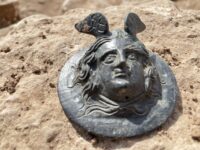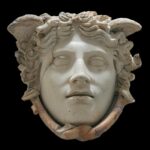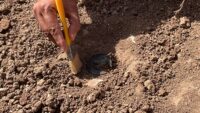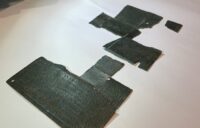 An 1,800-year-old medallion with the face of Medusa has been discovered in the ancient city of Perre in the southeastern Turkish province of Adıyaman. The bronze medallion features a high relief portrait of the Gorgon and is believed to have been an award given to a valorous soldier to wear on his shield or armour in military ceremonies.
An 1,800-year-old medallion with the face of Medusa has been discovered in the ancient city of Perre in the southeastern Turkish province of Adıyaman. The bronze medallion features a high relief portrait of the Gorgon and is believed to have been an award given to a valorous soldier to wear on his shield or armour in military ceremonies.
The earliest accounts of the Medusa myth describe her as a winged monster whose gaze turned all who beheld it to stone. The earliest depictions of her in Archaic art were unmistakably monstruous — round face with bulging eyes, wide-open mouth, protruding tongue, pointy teeth, tusks, even a beard. The iconography changed in the 5th century B.C. as artistic trend shifted to embrace notions of aesthetic beauty based in ideal symmetry and proportion. The grotesque Gorgon of the Archaic era was anthropomorphized, feminized and softened into a sort of dangerous beauty in the Classical era.
 The depiction of Medusa as the great beauty transformed by Athena into a monster with snakes for hair took firm hold in the 1st century B.C., sealed by Ovid’s account of the myth in Metamorphoses. He also explains the origin of the gorgoneion — a medallion with the head of Medusa — on arms and armature. Athena, Perseus tells us through Ovid, took the head of Medusa and affixed it to her shield to terrify her enemies.
The depiction of Medusa as the great beauty transformed by Athena into a monster with snakes for hair took firm hold in the 1st century B.C., sealed by Ovid’s account of the myth in Metamorphoses. He also explains the origin of the gorgoneion — a medallion with the head of Medusa — on arms and armature. Athena, Perseus tells us through Ovid, took the head of Medusa and affixed it to her shield to terrify her enemies.
The head of Medusa was deemed to have apotropaic power (the ability to ward off evil) and gorgoneia were ubiquitous in Greco-Roman antiquity. They were architectural features on city walls and temple friezes, common motifs on coins, intaglio gemstones, furniture, pottery and in imitation of Athena herself, on armour. Alexander the Great sports a gorgoneion on his cuirass in the famous Battle of Issus mosaic from the House of the Faun in Pompeii.
 The medallion found in Perre is in the style of the Medusa Rondanini, a 1st-2nd century A.D. Roman marble mask that is probably a copy of a Classical Greek original. The Gorgon is still intimidating, facing directly forward with her entrancing gaze, but she is a beauty, not a monster. The large wings that used to be on her back when she was a hybrid creature are now small winglets on the top of her head. The head covered in striking snakes is now just wavy hair. Only two small snakes remain, knotted tidily under her chin.
The medallion found in Perre is in the style of the Medusa Rondanini, a 1st-2nd century A.D. Roman marble mask that is probably a copy of a Classical Greek original. The Gorgon is still intimidating, facing directly forward with her entrancing gaze, but she is a beauty, not a monster. The large wings that used to be on her back when she was a hybrid creature are now small winglets on the top of her head. The head covered in striking snakes is now just wavy hair. Only two small snakes remain, knotted tidily under her chin.
 Last year’s excavation of the same area of Perre unearthed large fragments of a bronze military diploma from the 2nd century A.D. The Latin inscription on the bronze plate marks its owner as one Calcilius Antiquus who served two decades of military service in Syria and was honorably discharged by Hadrian in 123 A.D. The medallion is believed to be a little later in date than the diploma, but the discovery of two important pieces of military memorabilia suggests the area was at the least frequented by soldiers and veterans.
Last year’s excavation of the same area of Perre unearthed large fragments of a bronze military diploma from the 2nd century A.D. The Latin inscription on the bronze plate marks its owner as one Calcilius Antiquus who served two decades of military service in Syria and was honorably discharged by Hadrian in 123 A.D. The medallion is believed to be a little later in date than the diploma, but the discovery of two important pieces of military memorabilia suggests the area was at the least frequented by soldiers and veterans.